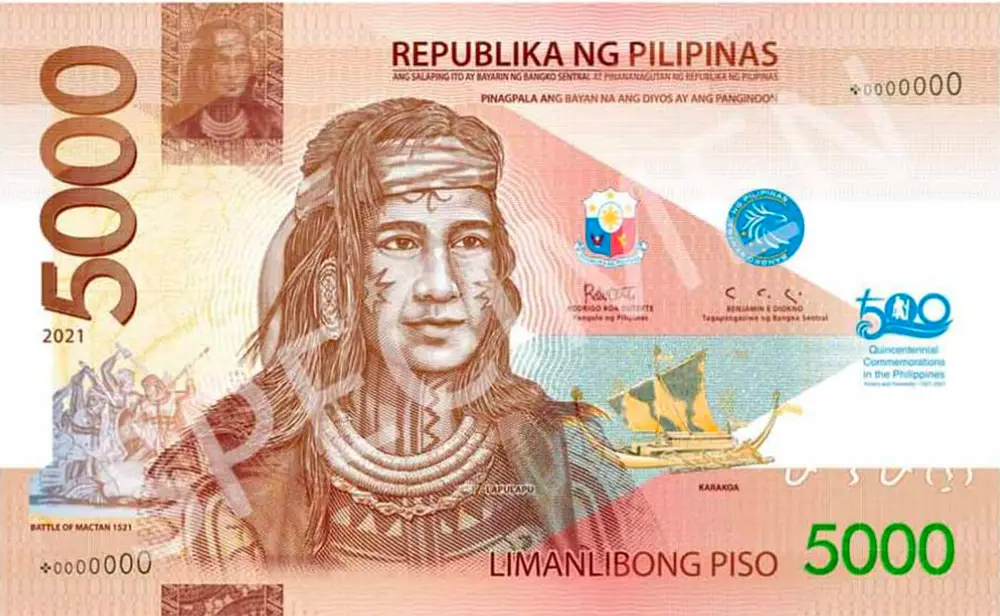The Bangko Sentral ng Pilipinas (BSP) launched the newest and the most sought after P5,000 banknote. This was in honor of the 500thanniversary of the “Victory at Mactan.”

Furthermore, the P5,000 banknote also kicks off the 99-day countdown to its exact anniversary this 2021.
Read: Filipinos are Eligible for US H-2B Visas Again
Francisco Dakila, BSP Deputy Governor, spoke during the event. He discussed some of the things you can see on the P5000 banknote.
Commemorative Banknote will “Not Be” Circulated to the Public
As much as we’re eager to get it, the P5,000 banknote is “not for circulation.” The note will only be available for purchase by the public and by everyone that needs it.
Meanwhile, the BSP will issue a separate and a different advisory in March 2021 for the guidelines on the purchase of the commemorative banknote.
Therefore, we wouldn’t be able to have as much information today.
Read Related: P300 Communication Allowance, Requested by Teachers From the DepEd
As per Dakila, the BSP and National Quincentennial Committee (NQC) collaborated on this commemorative banknote to celebrate the heroism of Lapu-Lapu and his warriors.
He said that this is to help the youth of our generation to be familiar with who Lapu-Lapu is.
To familiarize the present generation with the country’s rich pre-colonial history.”
Event at the Fort San Antonio Abad
Salvador Medialdea, the Executive Secretary, on behalf of President Duterte, has gotten a commemorative banknote and a medal.
He also shared a couple of thoughts during the ceremony; he encouraged Filipinos to mirror what Lapu-Lapu has done for us.
The event was held at the Fort San Antonio Abad in the BSP Complex in Manila.
Also Read: Beware of Fake Php10, 000 Bill, Warns the Bangko Sentral
Dakila, Officer-In-Charge of the BSP, said a message during the event. He did so in place of Governor Benjamin Diokno; he is still recovering from a medical procedure performed last Saturday addressing a blood clot.
During the event, Dakila also said that during this global crisis about the pandemic, we need a star reminder of our glorious past.
Now, more than ever, we need our heroes to remind us of our heritage and inspire us to overcome whatever challenge comes our way as a nation.”
Lapu-Lapu’s Heriosim
As per Diokno, Lapu-Lapu’s heroism is the one who led Visayan warriors, known as the pintados in conquering the Spaniards.
The BSP and the NQC have collaborated to produce this commemorative P5,000 banknote and medal to celebrate the heroism of Lapu-Lapu and his warrior and to retell their story to the present generation.”
Also Read: No-Faced 100 Peso Bill Affirmed By BSP, Investigation Ongoing
What Does the P5,000 Banknote Look Like?
Now, you might be curious of what the banknote looks like, right?

It will include an image of Lapu-Lapu on its front, a Philippines Eagle on its back, and the usual security features of the other peso banknotes.
Furthermore, it also depicts the Karaoka; he is a Filipino warship used during the time of Lapu-Lapu; as well as a coconut tree, the fruit of which was fed to Ferdinand Magellan and his crew.
The commemorative medal is made substantially of silver-like features the Lapu-Lapu shrine in Cebu on its front. There is also the battle of Mactan and the date “27 April, 1521” on its back.
Read Related: Extension of Electricity Bill Subsidy to 10 Years, Sought by Senator Gatchalian
On the other hand, the back side of the P5000 banknote depicts an image of the Manaol – the Philippine eagle. Diokno said that this is a representation of the ancient Visayan belief that discusses living creatures that has been pulled from it.
A coconut tree can also be seen on the back side of it because it’s known to be the Magellan-Elcano expedition. Lastly, the banknote also has a photo of Mt. Apo, the tallest and the largest mountain in the country.
The P5,000 commemorative bill has security features like micro prints, fluorescent, magnetic, and optically variable inks; it’s not so much different from the current paper money that we have.
Banknotes of the Philippine Peso
The front side of each banknote features prominent people along with building. Moreover, it also has most recent events in the country’s history while the reverse side depicts landmarks and animals.
On May 1, 1852 the first commercial bank of the Philippines, El Banco Español Filipino de Isabel II issued the following denomination initially 10, 25, 50, and 200 pesos Fuertes (strong pesos). It were used until 1896.
Read: ICT Getting a P21.4 Billion Budget in 2021, Duterte Administration
From the one-centavo coin where Lapu-Lapu was, he climbed up the ranks and is present on the future P5000 banknote.
What are your thoughts on the banknotes of the P5000 Philippine banknote bill? Do you think it’s fine that it wouldn’t be in circulation for the public?
Let’s wait on March to see how this will all pull out!
Source/s: The Philippine Daily Inquirer

